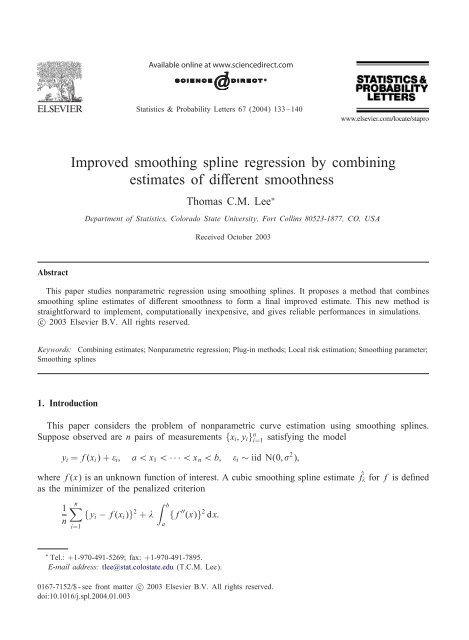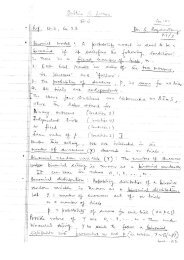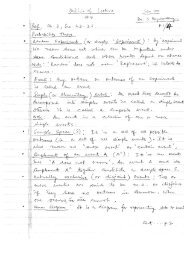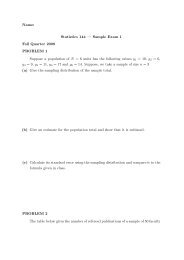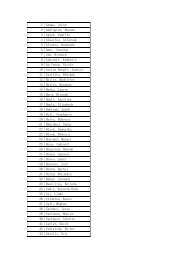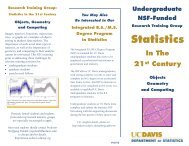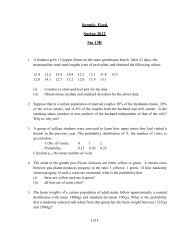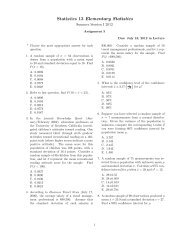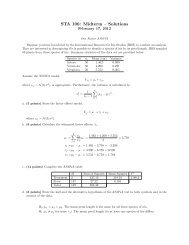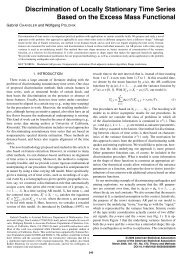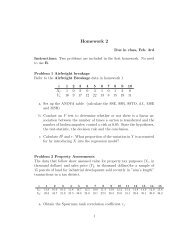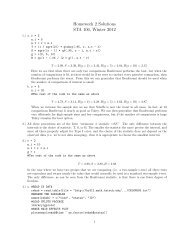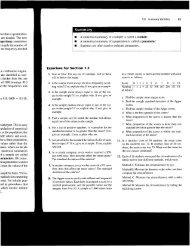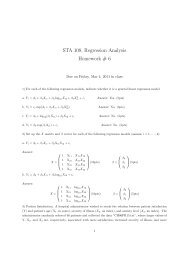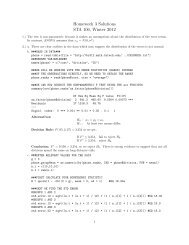Improved smoothing spline regression by combining estimates of ...
Improved smoothing spline regression by combining estimates of ...
Improved smoothing spline regression by combining estimates of ...
You also want an ePaper? Increase the reach of your titles
YUMPU automatically turns print PDFs into web optimized ePapers that Google loves.
Abstract<br />
Available online at www.sciencedirect.com<br />
Statistics & Probability Letters 67 (2004) 133–140<br />
<strong>Improved</strong> <strong>smoothing</strong> <strong>spline</strong> <strong>regression</strong> <strong>by</strong> <strong>combining</strong><br />
<strong>estimates</strong> <strong>of</strong> di erent smoothness<br />
Thomas C.M. Lee ∗<br />
Department <strong>of</strong> Statistics, Colorado State University, Fort Collins 80523-1877, CO, USA<br />
Received October 2003<br />
This paper studies nonparametric <strong>regression</strong> using <strong>smoothing</strong> <strong>spline</strong>s. It proposes a method that combines<br />
<strong>smoothing</strong> <strong>spline</strong> <strong>estimates</strong> <strong>of</strong> di erent smoothness to form a nal improved estimate. This new method is<br />
straightforward to implement, computationally inexpensive, and gives reliable performances in simulations.<br />
c○ 2003 Elsevier B.V. All rights reserved.<br />
Keywords: Combining <strong>estimates</strong>; Nonparametric <strong>regression</strong>; Plug-in methods; Local risk estimation; Smoothing parameter;<br />
Smoothing <strong>spline</strong>s<br />
1. Introduction<br />
This paper considers the problem <strong>of</strong> nonparametric curve estimation using <strong>smoothing</strong> <strong>spline</strong>s.<br />
Suppose observed are n pairs <strong>of</strong> measurements {xi;yi} n i=1 satisfying the model<br />
yi = f(xi)+ i; a¡x1 ¡ ···¡xn ¡b; i ∼ iid N(0;<br />
where f(x) is an unknown function <strong>of</strong> interest. A cubic <strong>smoothing</strong> <strong>spline</strong> estimate fˆ for f is de ned<br />
as the minimizer <strong>of</strong> the penalized criterion<br />
1<br />
n<br />
n<br />
{yi − f(xi)} 2 +<br />
i=1<br />
b<br />
{f<br />
a<br />
′′ (x)} 2 dx:<br />
∗ Tel.: +1-970-491-5269; fax: +1-970-491-7895.<br />
E-mail address: tlee@stat.colostate.edu (T.C.M. Lee).<br />
0167-7152/$ - see front matter c○ 2003 Elsevier B.V. All rights reserved.<br />
doi:10.1016/j.spl.2004.01.003<br />
2 );
134 T.C.M. Lee / Statistics & Probability Letters 67 (2004) 133–140<br />
1.0<br />
0.5<br />
0.0<br />
−0.5<br />
0.0 0.2 0.4 0.6 0.8 1.0 0.0 0.2 0.4 0.6 0.8 1.0<br />
(a) (b)<br />
1.0<br />
0.5<br />
0.0<br />
−0.5<br />
0.0 0.2 0.4 0.6 0.8 1.0 0.0 0.2 0.4 0.6 0.8 1.0<br />
(c) (d)<br />
Fig. 1. (a) True <strong>regression</strong> function with noisy observations; (b) true <strong>regression</strong> function (solid line) and <strong>smoothing</strong> <strong>spline</strong><br />
estimate (brokenline) computed with a small ; (c) similar to (b) but the <strong>smoothing</strong> <strong>spline</strong> estimate was computed using<br />
a large ; (d) similar to (b) but the curve estimate was obtained <strong>by</strong> the proposed method.<br />
Inthe above, is a positive constant known as the <strong>smoothing</strong> parameter. It controls the trade-o<br />
between the bias and the variance <strong>of</strong> f ˆ . For general references on <strong>smoothing</strong> <strong>spline</strong>s, see, for<br />
examples, Eubank (1988), Greenand Silverman(1994) and Wahba (1990). It is widely known<br />
that has a crucial e ect onthe quality <strong>of</strong> f ˆ . Popular automatic methods for choosing<br />
include cross-validation, generalized cross-validation, Mallows’ Cp criterion and the Akaike InformationCriterion.<br />
Descriptions onthese methods canbe found for examples inHurvich et al. (1998),<br />
Lee (2003b) and references given therein. In addition, Cantoni and Ronchetti (2001) study the robust<br />
tting <strong>of</strong> <strong>smoothing</strong> <strong>spline</strong>s.<br />
When the unknown function f consists <strong>of</strong> di erent spatial structures, it is <strong>of</strong>ten di cult to obtain<br />
a single fˆ that <strong>estimates</strong> f uniformly well across its entire domain. It is because slow-varying<br />
structures require a relatively larger to stabilize the variance while fast-changing structures require<br />
a relatively smaller to reduce the bias. Fig. 1 illustrates this point. A noisy data set, together<br />
with the corresponding f, are displayed inFig. 1(a). Fig. 1(b) displays a fˆ computed with a<br />
small . Notice that the curve estimate captures the fast-changing structures in the left portion <strong>of</strong><br />
f reasonably well, but undersmooths the remaining slow-varying structures. Fig. 1(c) displays a fˆ<br />
computed with a large , which demonstrates the opposite e ects. Thus it is strongly desirable<br />
to develop automatic methods for <strong>combining</strong> various f ˆ ’s (obtained from di erent ’s) together<br />
to form animproved nal estimate for f. The aim <strong>of</strong> this paper is to propose such a method.<br />
Fig. 1(d) displays the nal curve estimate obtained <strong>by</strong> this method.<br />
The rest <strong>of</strong> this paper is organized as follows. The proposed method is presented in Section 2.<br />
Section 3 studies the empirical performance <strong>of</strong> the proposed method via a simulation study, while<br />
conclusions are o ered in Section 4.<br />
1.0<br />
0.5<br />
0.0<br />
−0.5<br />
1.0<br />
0.5<br />
0.0<br />
−0.5
2. The proposed method<br />
2.1. General idea<br />
T.C.M. Lee / Statistics & Probability Letters 67 (2004) 133–140 135<br />
We rst provide a brief description<strong>of</strong> the proposed method. Suppose at each designpoint xi a set<br />
<strong>of</strong> di erent <strong>smoothing</strong> <strong>spline</strong> <strong>estimates</strong> fˆ 1(xi);:::; fˆ m(xi) are computed. The proposed method aims<br />
to choose the f ˆ (xi) that minimizes the following local risk calculated at xi:<br />
R (xi)=E{f(xi) − ˆ<br />
f (xi)} 2 :<br />
Of course, R (xi) is an unknown quantity and hence cannot be practically minimized. To overcome<br />
this problem anestimator for R (xi) is rst constructed and f ˆ (xi) is thenchosenas the minimizer <strong>of</strong><br />
the resulting estimator. This procedure is repeated for all xi’s and upon completion a nal combined<br />
estimate for f is obtained.<br />
2.2. Local risk estimation<br />
This subsection presents our method for estimating R (xi), and we need additional notation to<br />
proceed. Let y =(y1;:::;yn) T , f =(f(x1);:::;f(xn)) T and f ˆ =( f ˆ (x1);:::; f ˆ (xn)) T . Further, let S<br />
be the “hat” matrix that maps y into f ˆ : f ˆ = S y. One can show that S =(I + K) −1 , where I is<br />
the identity matrix and K is a matrix depending only on x1;:::;xn (see, e.g., Greenand Silverman<br />
1994, Chapter 2) Denote the ith element <strong>of</strong> the vector S f as (S f )(xi) and the ith diagonal element<br />
<strong>of</strong> the square matrix S ST as s (xi). The trace <strong>of</strong> a matrix A is denoted as tr(A).<br />
Straightforward calculation gives the following bias-variance decomposition for R (xi):<br />
R (xi)={(S f )(xi) − f(xi)} 2 + 2 s (xi): (1)<br />
2 We suggest estimating R (xi) <strong>by</strong> replacing the unknown quantities f and in(1) with pilot<br />
<strong>estimates</strong> (see below). Denote the subsequent estimator as ˆR (xi). Then, for each i, f(xi) canbe<br />
estimated <strong>by</strong> the f ˆ (xi) that minimizes ˆR (xi).<br />
For the pilot estimate <strong>of</strong> f , we use a <strong>smoothing</strong> <strong>spline</strong> estimate fˆ p where the pilot <strong>smoothing</strong><br />
parameter p is chosen<strong>by</strong> the AICc method proposed <strong>by</strong> Hurvich et al. (1998). This AICc method<br />
performed very well inthe simulationstudy conducted <strong>by</strong> Lee (2003b). For the pilot estimate <strong>of</strong><br />
2 ,weuse<br />
ˆ 2<br />
p =<br />
n<br />
i=1 {yi − ˆ<br />
f p(xi)} 2<br />
: (2)<br />
tr(1 − S p)<br />
Reasons for using tr(1 − S p) as the normalizing constant in ˆ2 canbe found for example inGreen<br />
p<br />
and Silverman(1994, Section3.4). By replacing the unknown quantities in Expression (1) for R (xi)<br />
with these pilots, our estimator for R (xi) admits the expression<br />
ˆR (xi)={(S ˆ<br />
f p)(xi) − ˆ<br />
f p(xi)} 2 +ˆ 2<br />
p s (xi); (3)<br />
where (S ˆ<br />
f p)(xi) istheith element <strong>of</strong> the vector S ˆ<br />
f p.
136 T.C.M. Lee / Statistics & Probability Letters 67 (2004) 133–140<br />
The above idea <strong>of</strong> local risk estimationhas beenused <strong>by</strong> Lee (2003a) in the context <strong>of</strong> penalized<br />
<strong>spline</strong> <strong>regression</strong> with spatially varying penalties.<br />
2.3. Practical implementation<br />
The proposed method can be implemented with the following steps:<br />
(1) For a set <strong>of</strong> pre-selected <strong>smoothing</strong> parameters 1 ¡ ···¡ m, compute the corresponding set<br />
<strong>of</strong> <strong>smoothing</strong> <strong>spline</strong> <strong>estimates</strong>: F = { fˆ 1;:::; fˆ m}.<br />
(2) Calculate the following AICC score for each member in F:<br />
<br />
{yi<br />
AICC( f ˆ<br />
− f ˆ (xi)}<br />
) = log<br />
2 2{tr(S )+1}<br />
+1+<br />
n<br />
n − tr(S ) − 2 :<br />
(3) The fˆ that gives the smallest AICC score is the (global) AICC <strong>smoothing</strong> <strong>spline</strong> estimate for<br />
f. Denote this fˆ as fˆ p, and calculate ˆ2 using (2).<br />
p<br />
(4) Substitute the pilots fˆ p and ˆ2 p into expression (1) and obtain ˆR (xi).<br />
(5) For each xi obtainthe f ˆ (xi) from F that minimizes ˆR (xi). This minimizer is the nal estimate<br />
for f(xi).<br />
In the above the most computationally demanding calculations are in Step 1. Notice that these<br />
calculations are also required for obtaining many traditional (global) <strong>smoothing</strong> <strong>spline</strong> <strong>estimates</strong> (e.g.,<br />
<strong>by</strong> cross-validationor AICC). Therefore the computational time required for the proposed method<br />
is not much longer than those traditional methods, as the additional calculations required in Steps<br />
3–5 are relatively minor.<br />
3. Simulation study<br />
This sectionreports the results <strong>of</strong> a simulationstudy that was conducted to evaluate the performances<br />
<strong>of</strong> the proposed methods together with two other <strong>smoothing</strong> <strong>spline</strong> methods existing in the<br />
literature. These two methods are the AICC method mentioned above and the RECP method studied<br />
in Lee (2003b). These two methods gave overall the best performances inthe simulationstudy<br />
conducted <strong>by</strong> Lee (2003b). Notice that these two methods are global innature.<br />
The experimental setup adopted here was essentially the same as Lee (2003b). This setup, originally<br />
due to Pr<strong>of</strong>essor Steve Marron, was designed to study the e ects <strong>of</strong> changing the (i) noise<br />
level, (ii) design density, (iii) degree <strong>of</strong> spatial variation and (iv) noise variance function in an<br />
independent and e ective fashion. The idea is as follows. Totally four sets <strong>of</strong> numerical experiments<br />
are to be performed. For each set <strong>of</strong> experiments, only one <strong>of</strong> the above four experimental factors<br />
(e.g., noise level) is changed while the remaining three are being kept unchanged. Within each set<br />
<strong>of</strong> experiments, the factor under consideration is changed six times, and hence there are altogether<br />
24 di erent con gurations. In this way the hope is that patterns can be more easily detected. The<br />
number <strong>of</strong> replications for each <strong>of</strong> the 24 con gurations were 200. For completeness, the setup<br />
speci cationis listed inTable 1.
Table 1<br />
Speci cation<strong>of</strong> the simulationsetup<br />
T.C.M. Lee / Statistics & Probability Letters 67 (2004) 133–140 137<br />
Factor Generic form Particular choices<br />
Noise level yij = f(xi)+ j i j =0:02+0:04(j − 1) 2 ; n= 200<br />
Designdensity yij = f(Xji)+ i =0:1, Xji = F −1<br />
Spatial variation yij = fj(xi)+ i<br />
j (Xi), n = 200<br />
=0:2;fj(x)= x(1 − x) sin[ 2 {1+2(9−4j)=5 }<br />
x+2 (9−4j)=5<br />
], n = 400<br />
Variance function yij = f(xi)+ vj(xi) i vj(x)=[0:15{1+0:4(2j − 7)(x − 0:5)}] 2 , n = 200<br />
j =1;:::;6; xi = i−0:5<br />
; n i ∼ iid N(0; 1); f(x)=1:5 ( x−0:35 x−0:8<br />
) − ( 0:15 0:04 )<br />
(u)= 1<br />
√ exp(<br />
2 −u2<br />
j+4 11−j<br />
); Xi ∼ iid Uniform[0; 1]; Fj is the Beta( ; 2 5 5<br />
0.4<br />
0.0<br />
−0.4<br />
0.8<br />
0.4<br />
0.0<br />
0.0<br />
j=1<br />
j=3<br />
−0.6<br />
0.0 0.4 0.8<br />
2<br />
1<br />
0<br />
−1<br />
−2<br />
j=5<br />
0.1 0.4<br />
−0.1<br />
0.0<br />
j=2<br />
j=4<br />
j=6<br />
0.4<br />
)c:d:f :<br />
−0.4<br />
−0.4<br />
−0.4<br />
0.4 0.8 3 2 1 0.0 0.4 0.8 2.5 2.5 1<br />
0.8<br />
0.4<br />
0.0<br />
−0.4<br />
1.0<br />
0.5<br />
0.0<br />
0.0 0.4 0.8 2.5 1 2.5<br />
1.0<br />
0.0<br />
−1.0<br />
2 3 1 0.0 0.4 0.8<br />
2<br />
1<br />
0<br />
−1<br />
−2<br />
0.0 0.4 0.8<br />
0.0<br />
0.8<br />
0.4<br />
0.0<br />
−0.4<br />
1.5<br />
1.0<br />
0.5<br />
0.0<br />
2.5 2.5 1<br />
2 2 2<br />
Fig. 2. Simulation results correspond to the noise level factor. In each pair <strong>of</strong> panels the left plot displays the true<br />
<strong>regression</strong>functiontogether with one typical simulated data set. The right plot displays the boxplots <strong>of</strong> the log e MSE<br />
values for, from left to right, AICC, RECP and the proposed method. The numbers below the boxplots are the paired<br />
Wilcoxon test rankings.
138 T.C.M. Lee / Statistics & Probability Letters 67 (2004) 133–140<br />
0.8<br />
0.4<br />
0.0<br />
−0.4<br />
0.8<br />
0.4<br />
0.0<br />
−0.4<br />
j=1 j=2<br />
0.0 0.4 0.8<br />
0.0 0.4 0.8<br />
0.4<br />
0.0<br />
−0.4<br />
0.4<br />
2 3 1<br />
j=3 j=4<br />
0.8<br />
0.0<br />
−0.4<br />
2 3 1<br />
0.4<br />
0.0<br />
−0.4<br />
0.0 0.4 0.8<br />
0.4<br />
0.0<br />
−0.4<br />
2 3 1<br />
j=5 j=6<br />
0.8<br />
0.4<br />
0.0<br />
1.0<br />
0.5<br />
0.0<br />
0.8<br />
0.4<br />
0.0<br />
0.6<br />
0.2<br />
−0.6<br />
−0.6<br />
−0.2<br />
0.0 0.4 0.8<br />
3 2 1 0.0 0.4 0.8 2.5 2.5 1<br />
0.5<br />
0.0<br />
−0.5<br />
0.8<br />
0.4<br />
0.0<br />
−0.4<br />
0.0 0.4 0.8 2 3 1<br />
Fig. 3. Similar to Fig. 2 but for the designdensity factor.<br />
For each simulated data set, we used the mean-squared-errors (MSE) to evaluate the quality <strong>of</strong><br />
any curve estimate f: ˆ<br />
n<br />
MSE = {f(xi) − f(xi)} ˆ 2 :<br />
i=1<br />
Boxplots <strong>of</strong> the loge MSE values for the 24 di erent con gurations are given in Figs. 2–5.<br />
Paired Wilcoxontests were also applied to test if the di erence betweenthe medianMSE values<br />
<strong>of</strong> any two methods is signi cant or not. The signi cance level used was 5%=1:67%.<br />
The methods<br />
3<br />
were also ranked in the following manner. If the median MSE value <strong>of</strong> a method is signi cantly<br />
less than the remaining two, it will be assigned a rank 1. If the median MSE value <strong>of</strong> a method<br />
is signi cantly larger than one but less than the remaining one, it will be assigned a rank 2, and<br />
similarly for rank 3. Methods having non-signi cantly di erent median values will share the same<br />
averaged rank. The resulting rankings are also given in Figs. 2–5, and the averaged rankings are<br />
tabulated inTable 2.<br />
The overall Wilcoxon test rankings for AICC, RECP and the proposed method are, respectively,<br />
2.29, 2.48 and 1.23. Therefore there seems to be some evidence to support that the proposed method<br />
is superior. In fact, out <strong>of</strong> the 24 di erent simulation con gurations examined, the proposed method<br />
scored rank 1 for 19 con gurations and shared the best rank for 3 <strong>of</strong> the 5 remaining con gurations.
1.0<br />
0.5<br />
0.0<br />
−0.5<br />
0.5<br />
0.0<br />
−0.5<br />
0.5<br />
0.0<br />
T.C.M. Lee / Statistics & Probability Letters 67 (2004) 133–140 139<br />
j=1 j=2<br />
1.0<br />
0.0 0.4 0.8<br />
2.0<br />
1.0<br />
0.0<br />
j=3 j=4<br />
0.8<br />
0.4<br />
0.0<br />
−0.4<br />
0.0 0.4 0.8 3 2 1<br />
j=5 j=6<br />
0.2<br />
0.0<br />
−1.0<br />
−0.3<br />
0.0 0.4 0.8 2 3 1<br />
0.5<br />
−0.5<br />
2.5 1 2.5 0.0 0.4 0.8<br />
0.5 0.6<br />
0.0<br />
−1.0<br />
0.5<br />
0.0<br />
−0.5<br />
0.0 0.4 0.8<br />
0.0 0.4 0.8<br />
1.5<br />
1.0<br />
0.5<br />
−0.5<br />
0.2<br />
−0.2<br />
0.4<br />
0.2<br />
−0.2<br />
Fig. 4. Similar to Fig. 2 but for the spatial variationfactor.<br />
Table 2<br />
Averaged Wilcoxon test rankings for the three <strong>smoothing</strong> methods<br />
3 1.5 1.5<br />
2.5 2.5 1<br />
2 3 1<br />
Noise level Design density Spatial variation Variance function Overall<br />
AICC 2.42 2.25 2.50 2.00 2.29<br />
RECP 2.17 2.75 2.17 2.83 2.48<br />
Proposed 1.42 1.00 1.33 1.17 1.23<br />
4. Conclusion<br />
In this paper a new method for performing <strong>smoothing</strong> <strong>spline</strong> <strong>regression</strong> is proposed. This new<br />
method combines <strong>smoothing</strong> <strong>spline</strong> <strong>estimates</strong> <strong>of</strong> di erent smoothness together to produce a nal<br />
curve estimate. The proposed method is straightforward to implement, computationally inexpensive,<br />
and possesses superior empirical properties.
140 T.C.M. Lee / Statistics & Probability Letters 67 (2004) 133–140<br />
j=1 j=2<br />
1.0 1.0<br />
0.5<br />
0.0<br />
−0.5<br />
0.8<br />
0.4<br />
0.0<br />
0.0 0.4 0.8<br />
−0.6<br />
0.0 0.4 0.8<br />
0.5<br />
0.0<br />
Acknowledgements<br />
0.6<br />
0.2<br />
−0.2<br />
j=3 j=4<br />
j=5 j=6<br />
1.0<br />
0.6<br />
0.5<br />
0.2<br />
0.0<br />
0.0 0.4 0.8<br />
0.6<br />
0.2<br />
−0.2<br />
−0.5 −0.2<br />
0.5 0.4<br />
0.0<br />
−0.5<br />
2 3 1 0.0 0.4 0.8<br />
2 3 1<br />
2 3 1<br />
−0.5<br />
−0.5<br />
0.0 0.4 0.8<br />
0.0 0.4 0.8<br />
0.0<br />
−0.4<br />
−0.4<br />
Fig. 5. Similar to Fig. 2 but for the variance function factor.<br />
0.5<br />
0.0<br />
0.8<br />
0.4<br />
0.0<br />
1.0<br />
0.5<br />
0.0<br />
2 3 1<br />
2 3 1<br />
2 2 2<br />
This research was supported in part <strong>by</strong> a grant from the U.S. National Science Foundation.<br />
References<br />
Cantoni, E., Ronchetti, E., 2001. Resistant selection <strong>of</strong> the <strong>smoothing</strong> parameter for <strong>smoothing</strong> <strong>spline</strong>s. Statis. Comput.<br />
11, 141–146.<br />
Eubank, R.L., 1988. Spline Smoothing and Nonparametric Regression. Marcel Dekker, New York.<br />
Green, P.J., Silverman, B.W., 1994. Nonparametric Regression and Generalized Linear Models. Chapman & Hall, London.<br />
Hurvich, C.M., Simono , J.S., Tsai, C.-L., 1998. Smoothing parameter selection in non-parametric <strong>regression</strong> using an<br />
improved Akaike information criterion. J. Roy. Statist. Soc. Ser. B 60, 271–293.<br />
Lee, T.C.M., 2003a. On <strong>spline</strong> <strong>regression</strong> with spatially-adaptive penalties. Unpublished manuscript.<br />
Lee, T.C.M., 2003b. Smoothing parameter selection for <strong>smoothing</strong> <strong>spline</strong>s: a simulation study. Comput. Statist. Data Anal.<br />
42, 139–148.<br />
Wahba, G., 1990. Spline models for observational data. CBMS-NSF, Regional Conference Series in Applied Mathematics.<br />
SIAM, Philadelphia.


